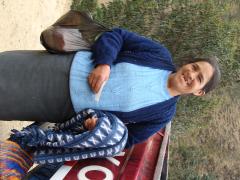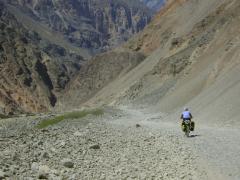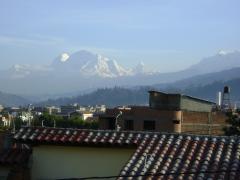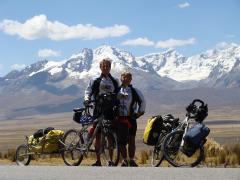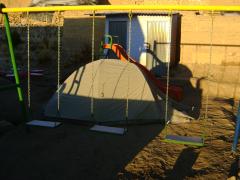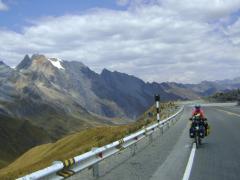rfay's blog
Working with Kiva and Microfinanzas Prisma in Huancayo
One of the objectives of our trip was to spend some time volunteering for various organizations, and getting to know the area and meeting the people that way. We volunteered with Friendship Bridge and Kiva.org in Guatemala last year, and Kiva was kind enough to set up a task in Huancayo and Tarma, Peru. Our job was to visit loan recipients, interview them so that we could write update their profiles on Kiva, and verify that the loan data were all correct.
Two marvellous young women hauled us all over the back country of Peru searching out the selected Kiva borrowers. In Huancayo we took more buses in one day than we could have imagined, visiting what seemed like dozens of little villages outside the city. In Tarma they arranged a 4-wheel-drive and a driver to haul us all over creation to find the clients. In one case we spent about an hour and a half climbing one incredible road up to a remote village... and then found that the woman was not home! However, we eventually found her husband and he was delightful. read more here... lee mas aquí... »
Saludos desde Huánuco, Peru
Beautiful Riding and The Rich Culture of the Peruvian Andes
We've just had the delight of riding right up into the Andes, over the highest pass of our trip, and over hundreds of kilometers of both paved and dirt road. It has to be some of the best bike touring we've ever done. And some parts of it were probably as hard as we've ever done.
In Huaraz, in the Cordillera Blanca, we looked out of our hotel window at the amazing peaks of the tallest mountain range outside the Himalayas. Huaraz is at about 3000 meters, or 10,000 feet. But from there we began to climb gradually to a pass at 4300 meters, then down a bit, then up to the biggest pass of the trip, at 4700 meters (15,400 feet). It was all incredibly beautiful.
But the best part all along the way was the people we met. There were shy families along the way, tending their sheep while knitting or spinning wool into yarn. One woman let Nancy hold her most prized lamb. We ran into celebrations in three different villages. They roped us into the dancing and the eating and the drinking. It was a delight. We stayed the night camped out with a Spaniard who is "getting away from it all" with a flourish - he and a friend showed Nancy how to pan for gold - and she found a little flake of gold in the Rio Maranon! Now she's rich and can afford the rest of the trip.
In Huánuco Pampa (Huánuco Viejo) we saw not only ancient Inca ruins but an amazing cultural competition, with planting and slingshot competitions along with potato peeling and spinning and rope braiding. read more here... lee mas aquí... »
Finance and Money Management On The Road
Lots of people ask us how we get money while travelling, and whether we carry a lot of cash, etc. Here's an attempt to answer your questions.
Money is obviously a big issue. You want to have enough, but not so much that you might lose it all at once.
These days it's just tremendously easy to get money from ATMs. The only exception to this that I know of is Cuba, and that's a whole different story. But everywhere we've been we're just a few days from an ATM. There are times the ATM doesn't work or won't dispense the amount of money we want, but the ATM has completely put away the use of travellers' checks (a waste of time and money) and the need to carry large amounts of dollars. (FYI: There are actually a number of machines in Latin America where you can withdraw dollars in addition to the local currency.)
Some tips:
- Use a debit card. It costs LOTS of fees to do a cash advance against a credit card.
- Find out from your bank how much it will cost to use your card at an ATM in Latin America. Some banks charge 2% of the advance and perhaps an additional transaction fee. Our bank (Fidelity) charges nothing. (The ATMS/Banks themselves sometimes charge a fee, but usually not. Sometimes there's a US$1.00 fee tacked on the statement. Sometimes there's a fee added at the ATM. Often there's no charge.)
- Carry at least two different debit cards, from different banks. Carry them in different places. Sometimes your bank will (for no reason or for a good reason) just stop letting you get money off of a card.
Gringo is not a bad word, and other misunderstandings
Everywhere we go in Peru the children cry out "Gringo!" It has happened in lots of countries, but they're SO enthusiastic about it here. Some cyclists misunderstand this cultural phenomenon and think that "gringo" has a negative context (or only applies to North Americans). It's just not true. Gringo is just a regular descriptive term, and everywhere we've been it just describes people who talk funny, wear funny clothes, have a funny walk, and probably have money. That even includes people from Chile, and can include kids from the city who dress like gringos.
Some people have heard the story that "gringo" was something said in Mexico during the various US invasions, and it referred to the green uniforms of the invading US troops, and they were saying "Green Go Home" or something. Well, it might be true (nobody knows) but is has nothing to do with what "gringo" means today. Gringo just refers to any north-American, European, Japanese, or most any foreigner who looks or talks funny. It's not an insult. Of course, like any descriptive term it could be used as an insult.
Another little Spanish word that confuses cyclists: Adios. You may have been taught that "Adios" means "goodbye", but in Mexico and Central America it means "Hi and Bye", kind of like I think "Aloha" means in Hawaii. read more here... lee mas aquí... »
Bike Maintenance In Latin America
People sometimes ask us what kind of bike we recommend, and how we manage bike maintenance. Here are some thoughts.
Ride a bike that's maintainable. In Latin America, that means a 26" mountain-bike style bike with standard components (V-Brakes or cantilever brakes, not disk brakes). You can buy 26" tires and tubes in even a small town, and you can find a mechanic who will have at least some tools for working on your bike. In a medium-sized town, you can get a rim and maybe spokes. If you have a 700cm wheel, you may have to send away to the nearest capital city and wait for a few days to get some of these things. Some people with difficult-to-obtain parts have spent lots of money on international shipping (and then on customs duties) and have waited ages to get going again when they've had a failure.
Ride a bike that's strong. It's better to be heavy than fragile. Get 36-spoke wheels (we're committed to this after a long failure of a 32-spoke back wheel in Canada. We haven't had a broken spoke since we switched to 36 spoke wheels). Get straight-gauge, strong spokes.
Carry a few spare parts. You can't carry everything. We always have tubes and patch kits, some spokes and the tools to replace them. Many people carry a spare tire. We don't, at least until now.
Keep the bike clean. We think that a bike that's clean doesn't wear as fast, especially the drive train. About every month, more in dusty dirt roads, less on clean pavement, we take our bikes and clean them and completely clean the chain and drivetrain. read more here... lee mas aquí... »
Camping Versus Hotels in Latin America
When other cyclists told us we would probably spend a lot of nights in hotels in Latin America, we kind of scoffed at them. As seasoned bike tourists, having camped all over the US and Canada, we figured we'd be camping more than most.
But we have been staying more than 80% of the time in hotels in Latin America (although that number is declining as we get farther south). People ask about this, so we thought we'd tell you why.
Camping in Latin America is different from camping in the US and Canada. There are no (or almost no) "official" campgrounds. It's really rare to see anything like that, and when you do, it's often more expensive than a hotel. And there is almost no "unclaimed" land, like in the western US or Canada. In the US and Canada, if you see a quiet place, you can just set your tent up there (if you're discreet) and nobody will ever know or bother you. In Latin America, almost everything is "owned". One time we set up discreetly behind a horse barn in a Mexican pasture right at dusk. Since we had run out of options, we just set up. We were immediately discovered. Some kids came and checked on us right away. Nobody bothered us, but we were not succeeding at hiding out. read more here... lee mas aquí... »
Our highest point yet: 15,400 feet (4700 meters)
Today we crossed the highest point of our journey so far, and perhaps the highest of the trip. After climbing back up into the Andes (the Cordillera Blanca) for more than a week, we crossed over 15,400 foot (4700 meter) Abra Yana Shalla. We had been working our way up to this, climbing no more than 1000 meters per day as we got into the really high places. Nancy really felt the altitude in a number of ways, so we were trying to be as careful as possible. But we made the last push this morning up into the barren peaks. We saw lots of beautiful scenery in the last few days and will try to get the pictures uploaded within a few days.

